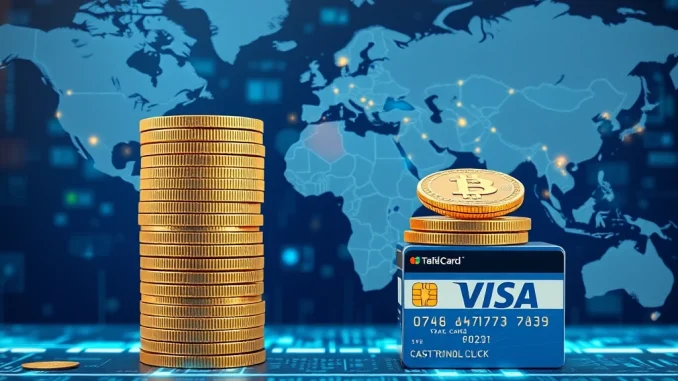
Imagine a world where digital currencies, specifically stablecoins, process more transactions than a global payments giant like Visa. Well, that world arrived in 2024. A recent report shared by Unfolded via X revealed a significant shift in the financial landscape: **stablecoin volume** has, for the first time, surpassed the transaction volume processed by Visa.
Stablecoin Volume Explodes Past Visa: The 2024 Milestone
This isn’t just a minor fluctuation; it’s a major milestone. The report indicates that the total transaction volume processed by stablecoins throughout 2024 exceeded that of Visa, a company synonymous with global card payments and vast financial infrastructure. For years, traditional payment networks have dominated the digital transaction space. This data point signals a powerful emergence of blockchain-based alternatives in the financial ecosystem.
While the exact figures fluctuate and methodologies can differ, the core message is clear: the activity happening on stablecoin networks is now competing on a scale previously reserved for established financial institutions. This development highlights the growing utility and adoption of stablecoins, moving them beyond niche crypto use cases into the realm of significant financial instruments.
What Drives This Massive Stablecoin Market Activity?
When we talk about **stablecoin market** volume, it’s important to understand where this activity comes from. Unlike Visa, which primarily handles consumer point-of-sale transactions and online purchases, stablecoin volume is generated by a different set of use cases:
- **Cryptocurrency Trading:** A substantial portion of stablecoin volume comes from trading pairs on exchanges (both centralized and decentralized). Traders use stablecoins to move in and out of volatile cryptocurrencies without converting back to traditional fiat, facilitating rapid transactions and arbitrage opportunities.
- **Decentralized Finance (DeFi):** Stablecoins are the backbone of many DeFi protocols, used in lending, borrowing, yield farming, and liquidity provision. The interactions within these protocols generate significant on-chain volume.
- **Cross-Border Transfers and Remittances:** Stablecoins offer a faster and often cheaper way to send value globally compared to traditional wire transfers. While still a smaller piece of the pie compared to trading, this use case is growing.
- **Emerging Payment Use Cases:** Although not yet mainstream, stablecoins are increasingly being explored and used for certain business-to-business transactions and, in limited cases, consumer payments.
It’s crucial to note that this volume isn’t directly comparable to Visa’s retail payment volume. Visa’s transactions represent millions of individual consumer purchases, while stablecoin volume is heavily influenced by large-value transfers between exchanges, DeFi protocols, and institutional traders. Nevertheless, the sheer scale demonstrates the increasing flow of value through blockchain networks.
Stablecoins vs. Traditional Digital Payments: A New Era?
This comparison between stablecoins and traditional **digital payments** providers like Visa prompts us to consider the evolving landscape. Here’s a simplified look at some key differences:
| Feature | Stablecoins | Visa |
|---|---|---|
| Underlying Tech | Blockchain (Decentralized) | Centralized Network |
| Primary Use Cases (Volume Driver) | Trading, DeFi, Transfers | Retail Purchases, Online Payments |
| Transaction Speed | Often faster (depending on blockchain) | Near-instant authorization, slower settlement |
| Fees | Vary (network fees, platform fees) | Merchant fees, interchange fees, cardholder fees |
| Accessibility | Requires crypto wallet/exchange | Requires bank account/card |
While Visa’s network is optimized for ubiquitous retail transactions and consumer protection, stablecoins offer programmability, speed (for settlement), and accessibility for those within the crypto ecosystem or those seeking alternatives to traditional banking rails. The fact that **stablecoins surpass Visa** in total volume underscores the significant economic activity occurring within the digital asset space, even if the nature of that activity differs.
The Future of Crypto Payments and Beyond
Does this mean everyone will be paying for their coffee with stablecoins tomorrow? Not necessarily. The path to mainstream **crypto payments** faces hurdles, including regulatory clarity, user-friendliness for non-crypto users, and widespread merchant adoption.
However, the volume data suggests stablecoins are already functioning as a critical layer in the digital economy. Their efficiency for large transfers, use in global trading, and potential for innovative financial applications position them as a powerful force. As infrastructure improves and regulatory frameworks develop, we may see stablecoins play a larger role in everyday transactions.
This 2024 milestone isn’t the end of the story, but a clear indicator of the growing influence and scale of the stablecoin market within the broader financial world. It challenges traditional payment paradigms and highlights the potential for blockchain technology to handle massive value transfers.
In conclusion, stablecoins reaching a higher transaction volume than Visa in 2024 is more than just a statistic; it’s a signal of the increasing maturity and economic significance of the crypto ecosystem. While use cases differ, this achievement underscores the power and potential of stablecoins as a fundamental component of the future of finance and digital payments.



